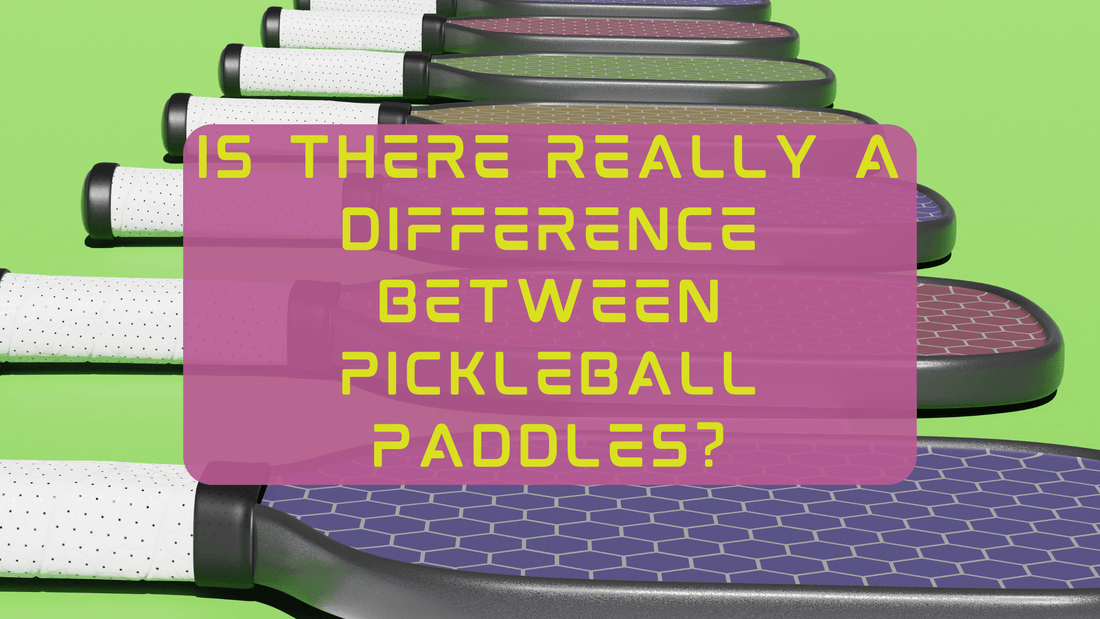
Is there really a difference between pickleball paddles?
Share
"Pickleball players often wonder if the racket truly makes a big difference. You might be asking, does it really matter? Well, consider this: each pickleball paddle carries its own unique traits – from materials and weight to grip size and surface texture.
It's not just about striking the ball; it's how your equipment complements your technique in South Africa’s diverse playing environments. As you look into Picklesport, understanding these nuances becomes key for crafting that perfect match between player ability and gear precision."
Exploring Pickleball Paddle Variations


You might wonder what difference a pickleball paddle can make to your game. You see, just like you wouldn't catch Ben Johns opting for subpar equipment against rivals Matt Wright and Riley Newman. Your choice matters too.
If embarking on What Is Pickleball in South Africa feels daunting, relax; as a rookie with zero racquet-sport history, fret not over fancy paddles now. Your journey's start only calls for basic gear. And steer clear of weighty wooden options!
As standards soar alongside skills past beginner levels, though? That's when nuances count. For intermediates hovering around 3.5 ratings pondering if it’s worth upgrading their kit.
A moderate investment is wise but won’t transform games overnight. However, leap further into the advanced zone and behold: selection precision becomes paramount! It hinges on understanding one's strong suits at play because function-fit paddles amplify proficiencies distinctly.
It could very well bolster those pivotal shots carving edges within competitive realms such as Pickleball South Africa contests.
Material Matters in Paddles
Material truly does make a difference in your pickleball paddle performance. Let's dive into how it aligns with play style and personal preference, shall we? If you're an aggressive player who thrives on versatility, consider the polymer core paddles.
They offer that sweet balance between power and control. Their durability is just icing on the cake. Now imagine you’re more about finesse.
Soft game enthusiasts benefit from lightweight kit. A thick graphite face perhaps. To neatly place those dinks without straining the arm.
And if raw power is your mantra, go for heftier paddles; thinner cores mean more pop when slamming those drives home. Choosing depends not only on playing personality but also physical comfort. The right thickness can shield against dreaded 'pickleball elbow'.
Savvy players match paddle attributes to their dominant techniques. Power seekers sometimes soften up with thicker cores while soft stylers may add a robust edgeless tool to command the kitchen area. It’s not all brute force or gentle taps; controlling energy transfer determines consistent shots no matter where they land on your racket. That said, always tailor choice towards amplifying strengths rather than simply compensating weaknesses for peak court triumphs!
Weight Affects Your Game Play

In your quest to dominate the pickleball court, grasping how paddle weight shapes gameplay is key. Lightweight models, sitting between 7.0 and 7.5 ounces, are akin to featherweight boxers - they're swift and deft at quick volleys by the net due to their nimbleness. An ideal match for those dodging tennis elbow or craving speed over raw power.
Simple: less strain on arms allows for a sprightlier play style without sacrificing your comfort. Especially when faced with rapid-fire exchanges within arm's reach of that slender white line. For versatility, consider midweights ranging from 7.5 to 8.2 ounces.
These paddles offer a perfect blend of control and power for serves and returns on South Africa’s courts. Opting for such gears you optimally both offensive heft and defensive agility irrespective of whether it's singles' precision or doubles’ chaos unfolding before your very eyes. A smart choice if unpredictability defines your playing mantra.
Grip Size for Comfort and Control
Grip size is pivotal in your pickleball play. It's the touchpoint where comfort meets control, shaping how you handle the paddle throughout a game. A grip that fits well prevents unnecessary strain on your arm and allows precise shot execution.
Opt for slightly larger grips if power strokes are your forte; they facilitate firmer holds translating to vigorous drives. Conversely, smaller grips enhance maneuverability for those deft at soft games. Where finessing dinks or crafting cunning drop shots takes precedence over sheer force.
Remember this: The right grip circumvents fatigue and augments performance by harmonizing with personal playing style. All while staving off potential injury risks. So whether you're rallying hard from the baseline or strategising around the kitchen-line, ensuring optimal grip size could very well be an unsung hero of your gameplay strategy.
Your choice reflects material considerations, as some materials may swell in colder conditions prevalent here. This is worth considering alongside thickness preferences when seeking the best paddle for support and agility in South Africa's diverse weather patterns. In summing up, selecting a fittingly sized grip isn't just about immediate comfort.
It's integral to longer-term physical health plus tactical prowess on court!
Paddle Core Types Explained
You'll want to choose a pickleball paddle that complements your playing style. If you're new, consider midweight paddles with larger heads for an even mix of power and control. Experienced players scrutinise their game; some might seek finesse enhancement while others aim to ramp up shot strength – each need dictates distinct paddle paths.
Your stroke’s nature matters too! Do heavy drives dominate your play? A heavier, elongated design suits those who commit fully to forceful hits, a style known as "banging." In contrast, aggressive play requires versatility from gear where soft touches matter just as much as strong shots.
For fans of the 'soft game,' mastering dinky netside exchanges is crucial. The right tool here offers superb handling for subtle plays rather than pure muscle-driving whacks over the network. Keep these considerations about player rating and strategy at heart when choosing: match them well, and watch how naturally victory follows on court.
Surface Texture and Ball Spin
Understanding the impact of surface texture on ball spin is essential for pickleball enthusiasts. Higher-quality paddles often feature carbon fiber surfaces, which excel in creating impressive revolutions per minute (RPM). This translates to better control and more strategic gameplay as the added spin can influence ball trajectory significantly.
When you choose a paddle with a raw carbon fiber face. Preferred by leading brands like Electrum and Engage. You're tapping into top-tier technology designed for enhanced performance.
Spin potential is paramount; this specific type ensures maximum grip on the pickleball, allowing precise shots that can outplay opponents. Keep an eye out though: not all gritty textures are equal! Shun those offering mere 'paint grit'.
It might seem effective at first but deteriorates swiftly. A risky choice if consistent play quality matters to you. Lastly, remember there's even regulation involved.
The USAP has set limits on the amount of grit permitted on paddles' faces! In short, don't compromise your game; invest in paddles that promote longevity and aid skill enhancement through superior design attributes such as legitimate texturing methods over superficial ones.
Balancing Power and Control
In your quest to choose the right pickleball paddle, understanding the difference between Power and Control variants is key. Go for a Power paddle if you're all about making those balls zoom across the court with vigour – they're often thinner at 13-14MM thick, enabling faster play. Opt for a Control paddle like Selkirk Luxx Control Air Invicta when precision rules your game.
Their thickness of around 16-20MM aids in strategic shot placement due to increased weight distributing steadiness during volleys, allowing more responsive touches. Think of it this way: wield a lighter Weight CONTROL model to finesse each serve or return gently where needed - think accuracy over strength here! Serious players analyze personal style attentively before deciding.
What matters most is how well the paddle complements your approach, whether dominating with power shots or outmaneuvering opponents through skillful control plays. Remember however: no matter which path you pick. Splendid performance hinges not just upon equipment but also dedication and skill enhancement.
Selecting a Paddle for South African Conditions
When selecting a paddle for pickleball in South Africa, focus on weight and size that suit local playing conditions. Since the sport puts less strain on your joints while demanding agility, you'll want a lightweight paddle to match this aspect of play. Something around 220 grams is ideal.
A narrow design enhances precision as opposed to padel rackets; it's vital when trying for those challenging shots across the net. Keep an eye out for length too. With more reach at about 40 cm long, controlling returns becomes easier which can give you an edge during fast-paced doubles games where reflexes matter most.
Unlike bulkier padel counterparts with foam cores and perforations designed mostly for comfort over control, pick these thinner yet firm-handed paddles keenly crafted from high-quality materials known to withstand rigorous use under our bright African sun. Your equipment should reflect both style and function because skill plays key roles. Footwork must be quick and deliberate, with movements well-coordinated to secure points until one achieves two clear ones from their opponent, sealing victory within three rounds or until someone hits eleven scores.
Evolution of Pickleball Equipment
In your quest for the ideal pickleball paddle, understanding its evolution is key. Pickleball paddles started simple but transformed significantly with each generation. Early versions were wooden; basic yet they did the job.
The revolution began when designers introduced a polymer honeycomb core beneath robust surfaces that reduced weight drastically while enhancing strength. Then came an innovative leap - 1.5 generation paddles with upgraded T700 carbon fiber allowing you to strike with more power and precision than ever before. Not stopping there, advances in foam technology brought second-generation geniuses who mastered vibration dampening and durability by injecting this evolved foam into their designs.
Modern thermoformed construction ensures consistency in shape, giving competitive players like yourself a dependable tool on court every time which align perfectly alongside South Africa's zeal for pickleball progressiveness! Remember: picking out today’s high-tech equipment means joining a lineage of innovation aimed at refining your game play experience.
Absolutely, pickleball paddles vary significantly. Wood, composite or graphite.
Affect weight and power. Heavier wooden paddles pack a punch whereas lighter graphite models allow for swift gameplay. Texture impacts ball spin; rough surfaces grip the ball better for more control.
Shape also plays a role: longer paddles offer reach on the court while wider ones provide larger sweet spots. Each paddle serves unique play styles and strategies in Pickleball Zone games, so choosing one can give you an edge!
References:
https://pickleballstudio.com/blog/does-the-paddle-you-use-really-matter
https://www.paddletek.com/blogs/news/paddle-difference-questions?srsltid=AfmBOort4LBMmw10x8SuYVjL7v3lrcC8RhAB1NBxAkryDUe_xwxo5LZB
https://www.thepickleballstore.co.uk/blogs/news/the-weighty-matter-of-pickleball-paddles-finding-your-perfect-match?srsltid=AfmBOopQK8SBFeUeZpQKbZcv9L6IPFUVEFV3VGJYQEOe5qshmwqkECBY
https://www.paddletek.com/blogs/news/paddle-difference-questions?srsltid=AfmBOopflD3fi-gk99D9Oi4HKZ59lqVOOLk4xRzjuVc_DuGgbKFj6yAu
https://www.paddletek.com/blogs/news/paddle-difference-questions?srsltid=AfmBOooFDSOLWLSU33NUMLfaxBkfonFS6dqA2G7BFsmQN3yiyKd9Cfbk
https://pickleballstudio.com/blog/breaking-down-pickleball-face-materials-and-grit-for-spin
https://pickleballtoday.co/what-is-the-difference-between-power-and-control-pickleball-paddles/
https://impactpaddle.com/blogs/news/the-evolution-of-pickleball-paddles-understanding-the-3-generations?srsltid=AfmBOopOfg7Iy9H94fmC0EYmMflM0EMEy5OWF02qF3CwpCNtbQ0hVJt_
